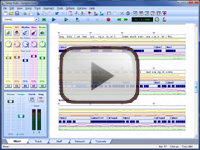(4.10) Bebop Scales
All Bebop scales are based on the Major scale, but they each have an additional note inserted in a different location, giving a characteristic short chromatic run within the scale.
These scales started to appear in jazz improvisation in the 1960's (Bebop itself is a style of jazz) as a way of enhancing the flexibility of the Major scale and achieving a more melodically interesting and complex sound.
The extra note also allows them to be used over a wider range of chords, so you usually don't have to change scales as often when improvising.
The Major Bebop scale is the Major scale plus an extra note between the 5th and 6th notes.

The Dominant Bebop scale is the Major scale plus an extra note between the 6th and 7th notes. This adds a flat seventh to the scale, which is the note that gives a dominant seventh chord its name.

The Minor Bebop scale is the Dorian scale (an important mode of the Major scale which we will meet later) plus an extra note between the third and fourth notes, giving it an ambiguous major/minor feel.

|
Topic 56 of 117
| ||
Bring these music concepts to life with the free Songtrix Bronze Edition as you create songs from chords and scales.
Then publish and share your ideas with the other musicians you meet on the ChordWizard Network.
Have questions? Join the ChordWizard Network and post them in the Music Theory forum for answers and discussions on your topics of interest.








